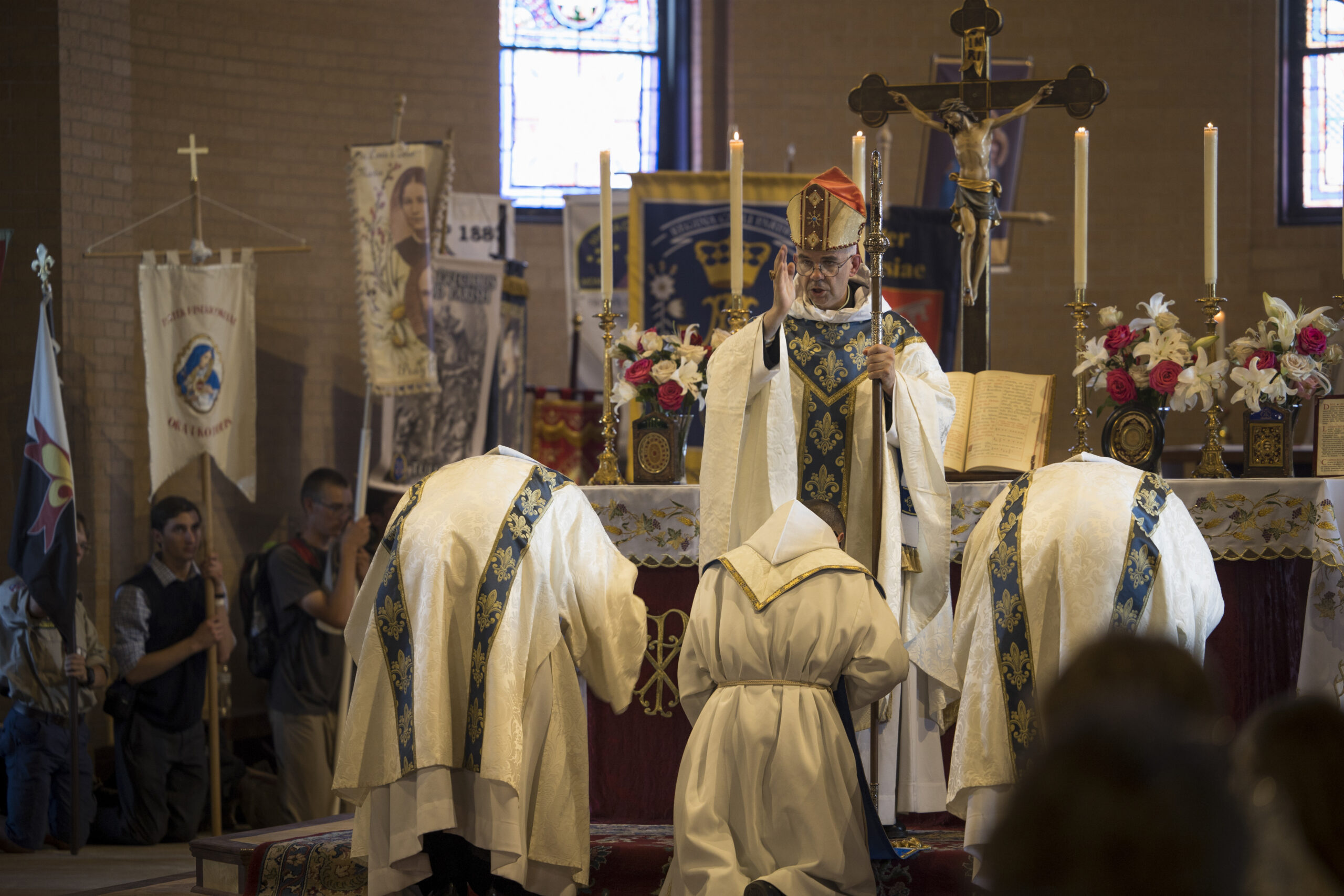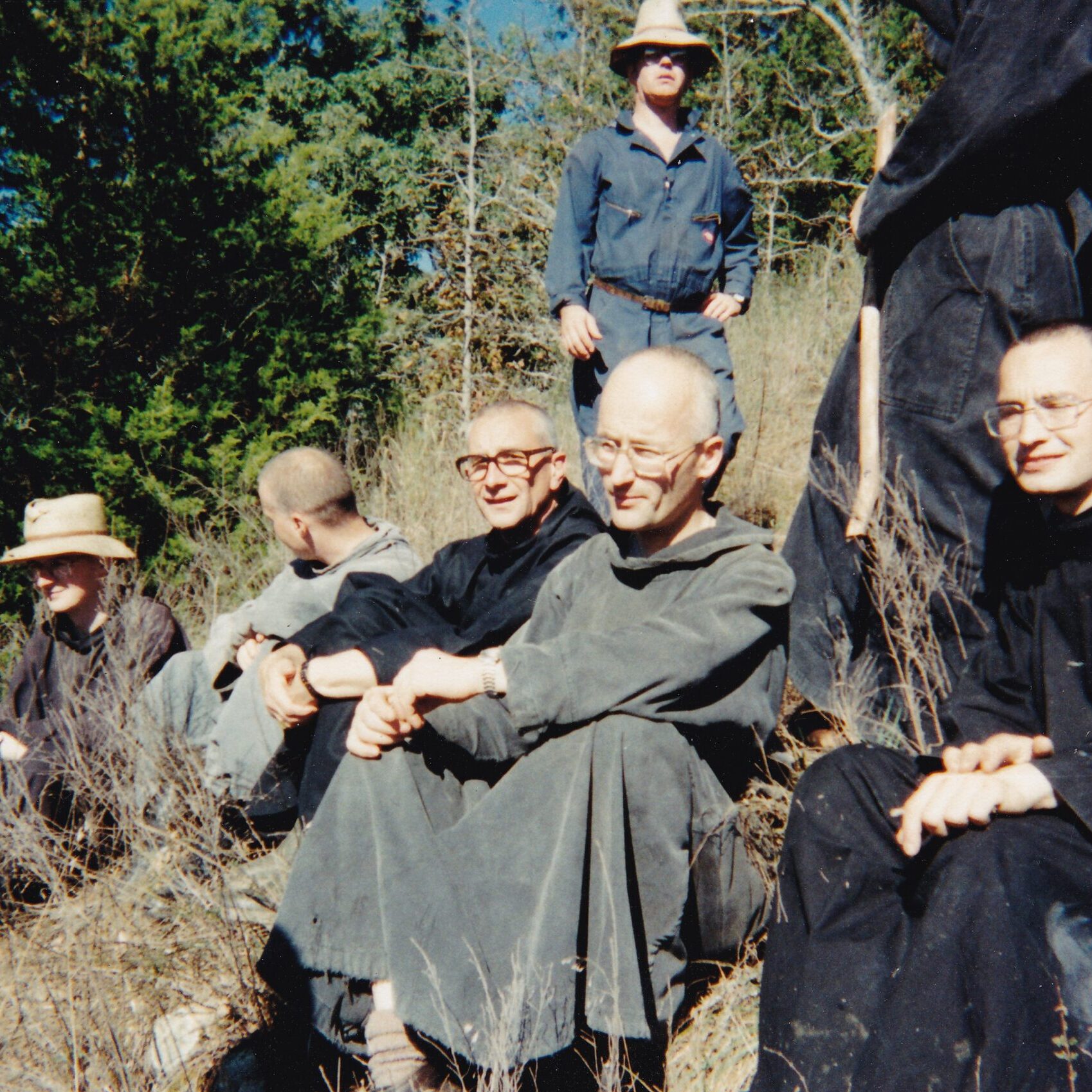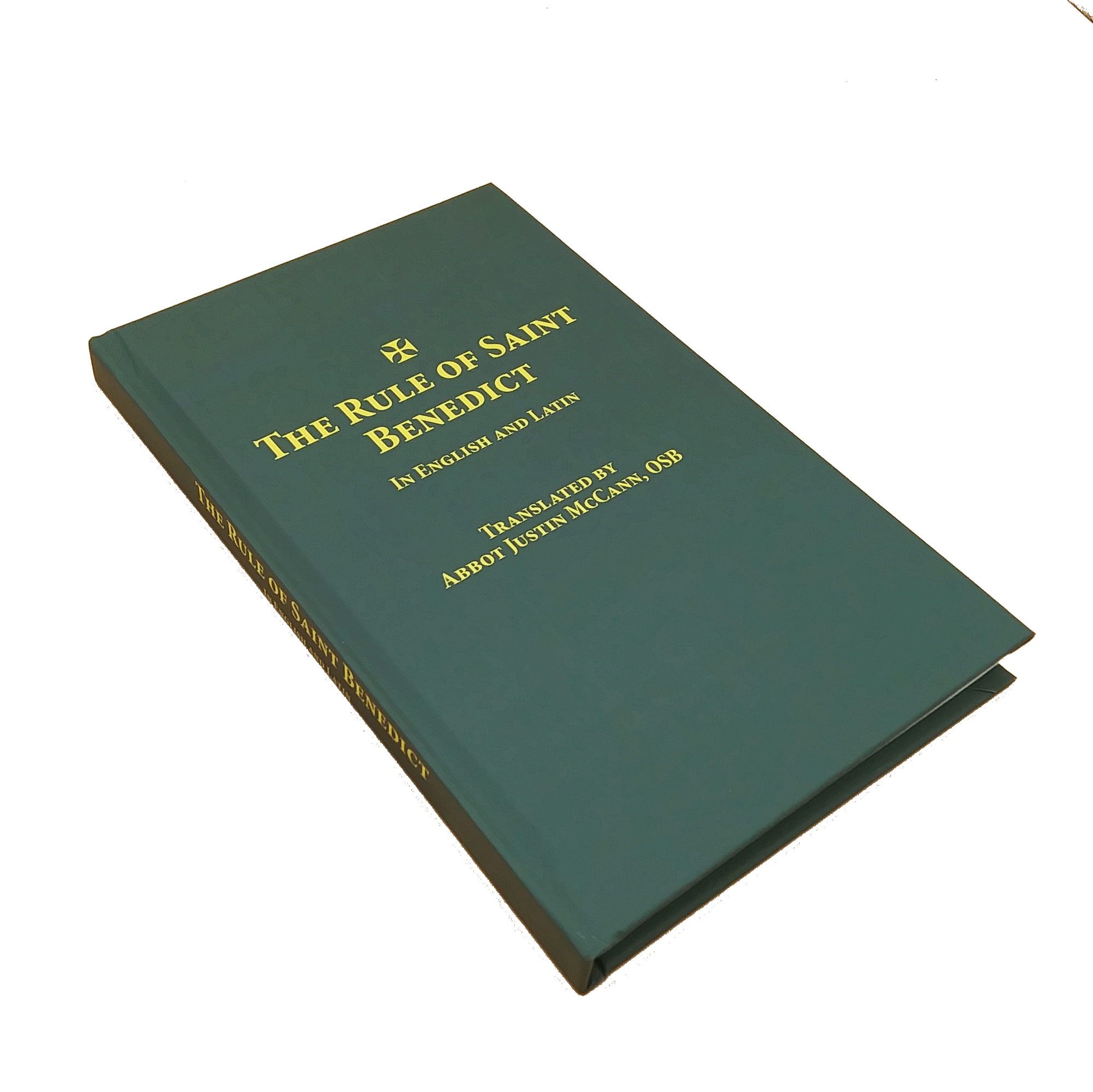Dear Friend of Clear Creek Abbey,
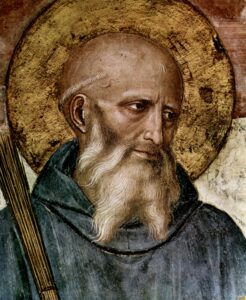
The thing was known. The son of Pietro di Bernardone, previously a turbulent youth, had experienced a real conversion. Observing this religious saga as it unfolded, some Benedictine monks who owned property in the area decided to let Francis and his band of followers use the Porziuncula, a small but beautiful chapel dedicated to Our Lady of the Angels, together with the land adjoining it, as a home for their new order. Since these new Brothers wanted to own nothing, it was understood that they would provide the Benedictines with a basket of fish each year as a kind of rent. This all happened some 800 years ago in a place close to the town of Assisi, birth place of Saint Francis, and not very far from the place where Saint Benedict and his sister, Saint Scholastica, also came into this world, in the town of Norcia.
Then there was this business of Miss Clare Offreduccio, the beautiful daughter of Favorino Sciffi, Count of Sasso-Rosso, and his wife Ortolana. Unfortunately for her parents (though most providentially in the eyes of God), Clare had fallen in love with the spiritual chivalry of Francis and chosen to follow him in the religious family that would later be known as the Franciscans. As previously planned by several pious persons, Saint Francis, one night by torchlight, cut her hair and had her clothed in the simple robe and veil of poverty. She too was helped by the Benedictines, by the Nuns who gave her shelter in various convents until a monastery was built for her and her companions near the church of San Damiano repaired by Saint Francis earlier. Here it was that this noble daughter of Assisi was to establish the Order of the Poor Ladies, later to be known as the Poor Clares. Mother Clare, the first abbess of this new plant in the garden of the Almighty, was later joined by her mother and sisters, not to mention by a great multitude of other women thirsting for evangelical simplicity and poverty in the footsteps of Francis.
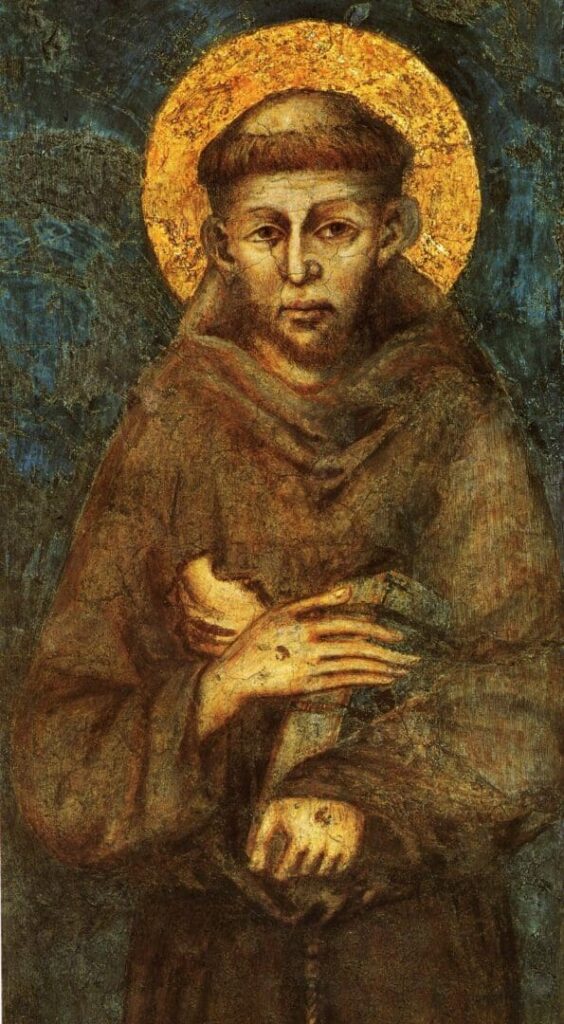
It was my great privilege and joy to make a pilgrimage recently, both to Norcia and to Assisi, in the heart of beautiful Umbria. The particular occasion of my voyage to Italy was to attend the blessing of the first abbot of the Benedictine monastery, now abbey, of San Benedetto in Monte, just outside the walls of Norcia. As I was to remain a few days in the vicinity, it seemed a golden opportunity to visit as well a place I had been to before becoming a monk, the holy citadel of Assisi. There was also the fact that a great series of anniversaries is currently taking place relative to the life of Saint Francis. Last December marked the 800th anniversary of the famous Christmas at Greccio. In September of this year, the faithful from all over the world will commemorate the 800th anniversary of the Stigmata of the Saint (feast on September 17th).
It was an American writer, I believe, who coined the expression “The Catholic Thing.” Much could be said about this remarkable utterance. Perhaps, one could also speak of a “Benedictine Thing” or of a “Franciscan Thing,” though these other articulations would really fit into the one Catholic Thing. The point is that there is a coming together of many things—and, in a true sense, of all things—in the overflowing fulness of what it is to be Catholic. Have we not forgotten this a bit, in our time of bitter culture wars that have somehow penetrated even into the innermost precincts of the Church? We Christians have always been obliged to defend the Faith from heresy and all sorts of errors, but God is not divided, and the internal unity of the Church, based on the Apostolic witness flowing from the eternal Gospel of the Lord, has never been compromised—despite distressing betrayals that, from time to time, rock the Bark of Peter, due to the human weakness, not of the Church, but of her churchmen (and women).
No doubt, we Catholics and all Christians would do well to remember in our days the prophetic words Saint John Henry Newman penned at the threshold of modern times:
See that you are not unsettled by [worldly change]; this is the danger; fear becoming unsettled. Consider that stability of mind is the chief of virtues, for it is Faith. ‘Thou wilt keep him in perfect peace, whose mind is stayed on Thee, because he trusteth in Thee;’ [Isa. xxvi. 3.] this is the promise. … Do not indulge visions of earthly good, fix your hearts on higher things, let your morning and evening thoughts be points of rest for your mind’s eye, and let those thoughts be upon the narrow way, and the blessedness of heaven, and the glory and power of Christ your Saviour. Thus will you be kept from unseemly risings and fallings, and steadied in an equable way. (Parochial and Plain Sermons, Volume 1, Sermon 19, “Times of Private Prayer”)
Let us ever live, imitating Benedict and Francis, in conspectu Angelorum, in the sight of the Angels (Psalm 137/138) like so many spiritual fish exploring the ocean of God’s Wisdom and Love. We monks hope to continue to be in some sense a factor of stability and a remedy for the unsettled state of contemporary things. Spiritually, we include you among the members of our larger monastic family, a family that has lasted already some fifteen centuries and will endure, no doubt, for many centuries to come, until the end of things. We count on your prayers and on your help in order to continue our mission in rural Oklahoma, geographically distant, but spiritually close to the lovely hills of Catholic Umbria.
br. Philip Anderson, abbot
Dear Friend of Clear Creek Abbey,

The thing was known. The son of Pietro di Bernardone, previously a turbulent youth, had experienced a real conversion. Observing this religious saga as it unfolded, some Benedictine monks who owned property in the area decided to let Francis and his band of followers use the Porziuncula, a small but beautiful chapel dedicated to Our Lady of the Angels, together with the land adjoining it, as a home for their new order. Since these new Brothers wanted to own nothing, it was understood that they would provide the Benedictines with a basket of fish each year as a kind of rent. This all happened some 800 years ago in a place close to the town of Assisi, birth place of Saint Francis, and not very far from the place where Saint Benedict and his sister, Saint Scholastica, also came into this world, in the town of Norcia.
Then there was this business of Miss Clare Offreduccio, the beautiful daughter of Favorino Sciffi, Count of Sasso-Rosso, and his wife Ortolana. Unfortunately for her parents (though most providentially in the eyes of God), Clare had fallen in love with the spiritual chivalry of Francis and chosen to follow him in the religious family that would later be known as the Franciscans. As previously planned by several pious persons, Saint Francis, one night by torchlight, cut her hair and had her clothed in the simple robe and veil of poverty. She too was helped by the Benedictines, by the Nuns who gave her shelter in various convents until a monastery was built for her and her companions near the church of San Damiano repaired by Saint Francis earlier. Here it was that this noble daughter of Assisi was to establish the Order of the Poor Ladies, later to be known as the Poor Clares. Mother Clare, the first abbess of this new plant in the garden of the Almighty, was later joined by her mother and sisters, not to mention by a great multitude of other women thirsting for evangelical simplicity and poverty in the footsteps of Francis.

It was my great privilege and joy to make a pilgrimage recently, both to Norcia and to Assisi, in the heart of beautiful Umbria. The particular occasion of my voyage to Italy was to attend the blessing of the first abbot of the Benedictine monastery, now abbey, of San Benedetto in Monte, just outside the walls of Norcia. As I was to remain a few days in the vicinity, it seemed a golden opportunity to visit as well a place I had been to before becoming a monk, the holy citadel of Assisi. There was also the fact that a great series of anniversaries is currently taking place relative to the life of Saint Francis. Last December marked the 800th anniversary of the famous Christmas at Greccio. In September of this year, the faithful from all over the world will commemorate the 800th anniversary of the Stigmata of the Saint (feast on September 17th).
It was an American writer, I believe, who coined the expression “The Catholic Thing.” Much could be said about this remarkable utterance. Perhaps, one could also speak of a “Benedictine Thing” or of a “Franciscan Thing,” though these other articulations would really fit into the one Catholic Thing. The point is that there is a coming together of many things—and, in a true sense, of all things—in the overflowing fulness of what it is to be Catholic. Have we not forgotten this a bit, in our time of bitter culture wars that have somehow penetrated even into the innermost precincts of the Church? We Christians have always been obliged to defend the Faith from heresy and all sorts of errors, but God is not divided, and the internal unity of the Church, based on the Apostolic witness flowing from the eternal Gospel of the Lord, has never been compromised—despite distressing betrayals that, from time to time, rock the Bark of Peter, due to the human weakness, not of the Church, but of her churchmen (and women).
No doubt, we Catholics and all Christians would do well to remember in our days the prophetic words Saint John Henry Newman penned at the threshold of modern times:
See that you are not unsettled by [worldly change]; this is the danger; fear becoming unsettled. Consider that stability of mind is the chief of virtues, for it is Faith. ‘Thou wilt keep him in perfect peace, whose mind is stayed on Thee, because he trusteth in Thee;’ [Isa. xxvi. 3.] this is the promise. … Do not indulge visions of earthly good, fix your hearts on higher things, let your morning and evening thoughts be points of rest for your mind’s eye, and let those thoughts be upon the narrow way, and the blessedness of heaven, and the glory and power of Christ your Saviour. Thus will you be kept from unseemly risings and fallings, and steadied in an equable way. (Parochial and Plain Sermons, Volume 1, Sermon 19, “Times of Private Prayer”)
Let us ever live, imitating Benedict and Francis, in conspectu Angelorum, in the sight of the Angels (Psalm 137/138) like so many spiritual fish exploring the ocean of God’s Wisdom and Love. We monks hope to continue to be in some sense a factor of stability and a remedy for the unsettled state of contemporary things. Spiritually, we include you among the members of our larger monastic family, a family that has lasted already some fifteen centuries and will endure, no doubt, for many centuries to come, until the end of things. We count on your prayers and on your help in order to continue our mission in rural Oklahoma, geographically distant, but spiritually close to the lovely hills of Catholic Umbria.
br. Philip Anderson, abbot


